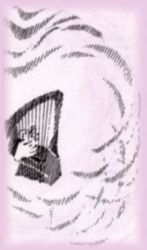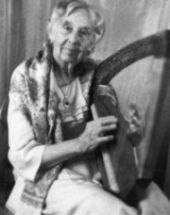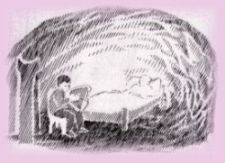 |
The Bridge from man to man
Working with handicapped people and old people
|
|
The therapeutic
value of the large
Gärtner Kantele ,,Some time ago
Horand
Gärtner gave me a large
diatonic Kantele for use in
our institution with the
request to try it out in our
work with mentally handi-
capped children and then to
report back so that our find-
ings might be used in further
development of the in-
strument. From the start of my
music therapy work the main
concern had been to find
an instrument which even a
very handicapped child could
play unaided and in a
free way gain musical ex-
perience. Playing together and
also exchanging tone sequences
is a music experience
the charm of which no one has
so far been able to resist. |
After
much experimenting
with the sound of these
instruments we began to use
them in music therapy
with our children in
need of special care.
lt was very soon
quite evident that
the sound of these
instruments has a
particularily harmonising in-
fluence upon the child, the
child listens attentively
to the sound and its
respiration changes to a
deeper and more regular
breathing. A smal
l six year old boy
had great difficulties
going to sleep.
To play a melody
at bedtime did not
help him because
in his compulsiveness
he had either to copy
or anticipate the melody.
However, after the
Kantele had been retuned
to harmonious chords,
he fell asleep after
a few minutes of playing.
With spastic children
we observe a loosening
of rigidity and spasticity
when hearing the instrument. |
But
the most convincing
proof of the therapeutic
value of this instrument was
supplied by a seven year old
suffering from compulsive
and extreme hyperactivity.
While in the throes of an
acute attack his blood pressure
would diminish to a life
threatening level. To help
this child I rest the back
of the Tenor Kantele against
his back in the prestage to such
an attack. With regular
stroking movements I begin
to build up the chords from
below upward until the full
spectrum of all three chords
sound, and then I reduce the
sequence downward again
until only the last lowest note
sounds alone. The great
resonating capacity of this
instrument has an almost
immediate harmonising effect"
(Extract from a text
by Martin Jung, music therapist) |
|
|
|
|
|
|

Playing the Lyre
as a therapeutic
experience ,,Just barely touching
the strings while
gliding over them
of even a simple Wing-
kantele, tuned to a high or
lower scale, will enhance
sensitivity in the fingertips.
This can be further
enhanced by a gentle or
stronger striking of the |
string
with one's fingertip.
Alternatively by gently
or more firmly depressing
the string and then
releasingit the resulting
tone varging quality
according to the touch
employed can be experienced
as radiating toward one's
head. Next one may reach smaller
or greater distances and
tone intervals or experiment with
playing between right and left hand
as question and answer or
extending a motif like a musical
conversation. The large area of
different harmonies offer a
rich field of therapeutic
possibilitie Excercises might
consist of changes from
major to minor, resolving
dissonance into harmony.
Working with such musical
contrasts helps to resolve conflict
and achieve resolution in the
soul and creates equilibrium."
Extract from
,,Die hohe Schule des Leierspiels"
by Elisabeth Gärtner,
see left picture |
 |
|
|
|
|
|
Friend and helper
in old age ,,Being myseif very weil
advanced in age, I wish to acquaint
you with a special friend and helper.
This helper is a harp-like instrument,
called a Lyre. Beholding its forms
may already convey wellbeing, its
somewhat magic and lightfilled and
uplifting sound is able to loosen
tenseness of soul and lighten the
burdens of everyday experience or
old age. Even though the Lyre is
an instrument offering all artistic
qualities to a trained musician, a
layman too will find it simple enough
to play and gain jjoyful and memorable
experiences from it. Whether the
patient holds the instrument on his
or her lap while sitting in a wheelchair |
or
the Lyre is
laid flat on the covers
of the bed: making the
strings sound either
by gliding over them or
striking them individually
can convey peace and
joy. The blossoming
out and bosening
effect of the tranquil
tones may overcome
feelings of weight and
gravity and be well
suited to accompany
the last, sometimes
difficult, moments of
life. In the Lyre we
have'a valuable tool
which can have
beneficial effects in all
stages of life, but
especially in old age it
may become a much
appreciated companion."
(Extract from a
text by Elisabeth Gärtner) |